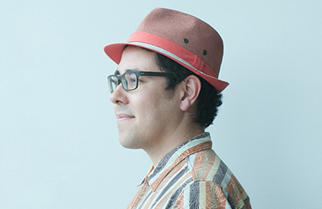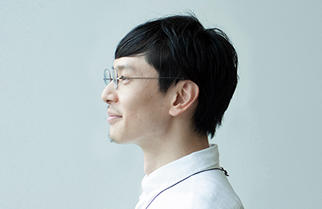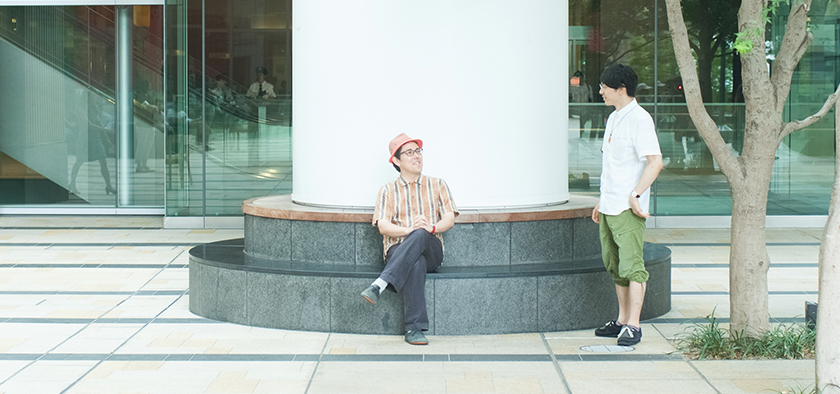
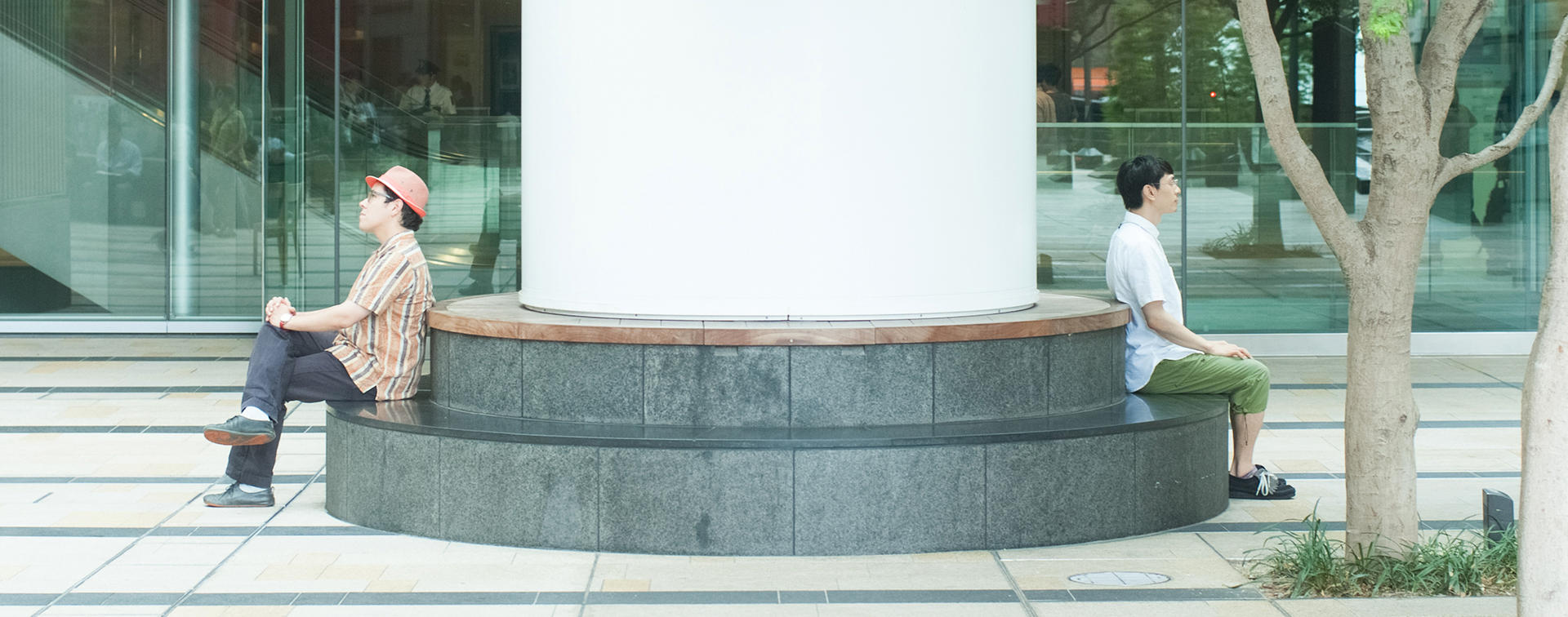
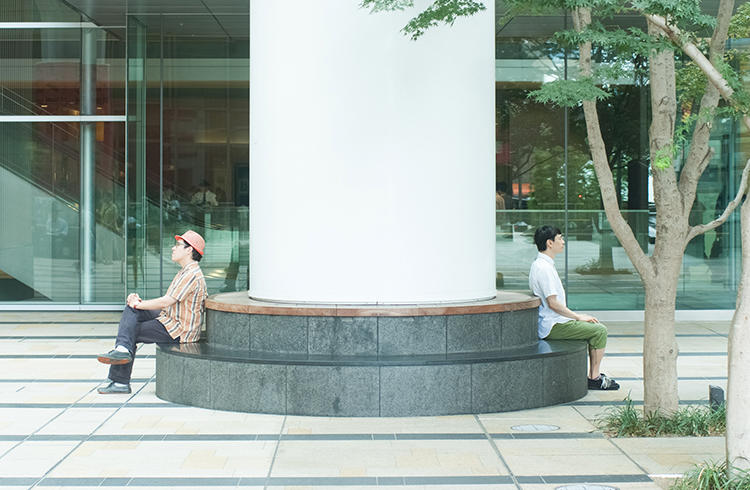
interview to creators Creating “gaps” to encourage new movements
Community is the key _ becoming personally inovolved with the town -Suzuki Making a town where surprises occur every day -Kanematsu
With the renewal of the Roppongi Future Talks site, we have started a new series of interviews to creators. Creators will be looking at certain possible "problems" in Roppongi and presenting their ideas to solve them and for specific action that could be taken. For the first round, we interviewed Nao Suzuki and Yoshihiro Kanematsu who run the web magazine "greenz.jp." With the slogan of "Let's make the future we want", the magazine collects good ideas for bringing change to our everyday lives and to the world. Suzuki lives in Chiba and Kanematsu lives in Kagoshima; the two non-Tokyo residents agreed that what Roppongi needs are "gaps."
A night town and a foreigners' town and today's calculated spaces
Nao Suzuki My father used to work in Hiroo as an architectural consultant for foreign companies, so I was initially a resident of Minato City. My father's job often involved working with engineers and legal specialists who came from abroad, and some of them would wish to stay in Roppongi. I have memories of accompanying my father on the weekends to help with the moving in.
Yoshihiro Kanematsu I was born in Akita Prefecture, so when I first came to Roppongi, I was very tense. I had this preconceived image in my mind of it being a night town and a foreigners' town. (laughs) I have many memories of Roppongi. Before construction of Roppongi Hills began, there was an experimental space called "New Tokyo Life Style Think Zone"; I was a college student then and I was really stunned by this space. By coming into contact with the latest art in the streets, I became interested in coming to Roppongi and having the kind of fun that is possible only here - different from the fun in Shinjuku and Shibuya.
New Tokyo Life Style Roppongi Think Zone
An art space that was opened in 2001 as a project to precede the construction of Roppongi Hills. On the ground, a huge 14×18m screen was set up, and numerous events were held featuring the latest art, sound and images. (The facility is now closed.)
When I started working as a web designer in Ebisu, there were times when I would work all night and go to the Aoyama Book Center Roppongi store at around four in the morning. Then I would go back to work again. I relied on that bookstore so much that when there was talk at one time of the store closing down, I actually cried. But I've never thought of living in or being involved with Roppongi; it's always been a town where I am simply the consumer.
Suzuki I often come to Roppongi these days. Whenever I have meetings here, I always check the museums, and if there's something that catches my attention, I wander in. On my days off, I come with my children to see the movies.
Kanematsu In the last ten years, Roppongi Hills and Tokyo Midtown have been built, and the image of Roppongi has changed rapidly into that of an area of design and art. I think this is quite a remarkable thing. During the DESIGN TOUCH event, lots of people gathered on the lawn beside Tokyo Midtown and it was very peaceful.
Recently, there was the Exhibition "Design Ah!" which drew a huge crowd. It was an event that allowed both parents and children to enjoy design and art, and at the same time it was so popular that people were waiting in lines - I think it was groundbreaking in that sense.
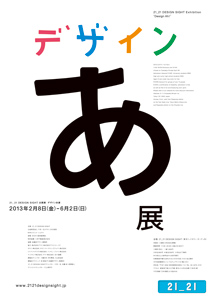
Exhibition "Design Ah!"
Held at 21_21 DESIGN SIGHT from February 8 to June 2, 2013, the exhibition was based on the educational "Design A" program on NHK E TV. Using sounds and images, the experience-oriented exhibition provided fun and inspiration to both children and adults while encouraging them to think about designs.
Suzuki There have also been events like the Ukiyo-e exhibition; I admire the stance of selecting things of excellence and showing them to the public. But it seems to me that that the spaces in Roppongi have a carefully calculated look. It's as if a proper plan has been drawn up, and development is being made in an orderly way. Efforts have obviously been made, and the challenge is continuing to be taken to create design, art and a high-brow culture. Yet I get the feeling that Roppongi is not a town where new movements can be easily born.
New movements always emerge from "gaps"
Suzuki I think that new things of the kind you have never seen before can only emerge from "gaps". The things that began from the "gaps" in society gradually evolve and are eventually exhibited in art museums. In this flow, Roppongi seems to be just the point of final destination.
A few years ago, I moved to Sotobo in Chiba which has a very strong frontier spirit. The place itself is interesting; there is the sea and empty, unused houses, and there are also many interesting people. The land prices are cheap so you can easily open a shop or experiment in daily life - such as setting up a wood-burning stove. There are so many spaces that allow you to do anything as long as you know how to do it; there are plenty of "gaps" which stimulate creativity.
In comparison, in Roppongi today, it's as if the people who are active are limited to those at the top of the cloud-covered mountain. In order to make Roppongi a more attractive town, I think more "gaps" need to be created.
The easiest way to do this is to use public spaces. Perhaps you could hold "artist in residence" programs where artists make works while staying in Roppongi, or perhaps the parks and squares could be opened up to the people of the town. From the viewpoint of economic principle, there may be no point in doing these things. But I think it would be interesting if the challenge could be taken to create dynamic spaces not only in Roppongi Hills and Tokyo Midtown, but also in the surrounding, cluttered areas.
Active movements in design and art often happen in places that have been generally discarded - as in SoHo, New York, in the 1960s-70s. Housing rents there used to be cheap, so the garages were turned into ateliers, and there was an emergence of all kinds of artists.

Planning surprises and becoming more spontaneous
Kanematsu New York certainly has very pleasant "gaps". There is a blending of art and surprise in the streets. In Times Square, for example, I saw a lectern attached with the sign "Say something nice" together with a megaphone, and people were shouting things like "Your clothes are awesome!" There is tolerance for things like that.
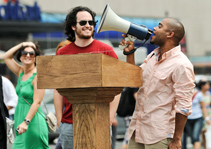
Say Something Nice
Themed on finding places of respite in the city, this project was part of an exhibition by Guggenheim Museum and was undertaken by the performance group "Improv Everywhere". Many pedestrians of all ages used the megaphone to send out nice messages into the streets.
We may not be aware of it, but perhaps Roppongi has such "gaps" too. Last summer, I dressed up as Santa Claus for somebody's birthday and stood at the Roppongi exit of the Oedo subway line. It was in the middle of summer and I was wearing a false moustache and a jacket. But the person I was waiting for didn't arrive at the appointed time, so I was standing there for quite a while...
Suzuki You can expect nothing less from greenz's chief surprise officer!
Kanematsu This was part of a project called "Santa no yome" (Santa's wife). We plan surprises and try to circulate happiness; we pour a lot of energy into the scenario each time and it's fun. I had thought up the character for Santa, so when someone came up to talk to me now and then, I would go "hoo, hoho!" and act as if I didn't understand Japanese. (laughs)
I think if I had been standing in Shibuya, people would probably have poked a lot of fun at me. If it had been my hometown in Kagoshima, I would definitely have been confronted by some middle-aged woman demanding to know what I was doing. But in the streets of Roppongi, the pedestrians didn't seem to be particularly surprised; it's as if they were thinking, "There are people like that." They left me alone, giving me this very comfortable distance, and yet allowing me to kind of take the stage, and I found it unexpectedly pleasant.
Roppongi probably has the same atmosphere as in New York which is tolerant of impromptu moves. We are probably not usually aware that these "gaps" exist because we - including myself - tend to put the brakes on. I think there are ways to become less self-restrictive though.
Suzuki What exactly do you have in mind?
Kanematsu I think it would be interesting if it became normal for Roppongi to have surprises in all kinds of places every day. For example, your favorite bakery might be having its 30th anniversary. You could get together with other patrons and do something to celebrate the bakery's 30 years, showing your appreciation by planning a surprise: someone could think up the scenario, someone could shoot the video, someone could make the props - everyone could do something to contribute.
What matters is ingenuity and ideas - spending more money does not necessarily make it better. The good thing about planning surprises is that you have to do it in secret. By sharing a secret, the members get to know each other better and the community becomes tighter-knit.
Suzuki But how would you get the people together?
Kanematsu I would wait outside the store and talk to the people who come out of it. (laughs) If you can get a group of about three people, it would probably be enough. It's like Derek Sivers's "How to start a movement" - you know, the video you said you like, Nao-kun.
http://www.ted.com/talks/derek_sivers_how_to_start_a_movement.html (Japanese subtitles are also available)
Suzuki There's a guy at a festival doing a weird dance, and another guy starts imitating him. When the third guy starts doing the same dance, the others are encouraged to do it as well. A surprise move by just one person is spontaneously relayed to other people, and a movement is born.
Kanematsu If you say "Here is the stage. Please do something on it," people will get tense and no one will dance, but people will be motivated if you say, "Let's do something together to please 'so-and-so', the store manager." In Roppongi, there are many shops which have their own philosophy and it must be easy to talk to people who love the same stores that you do.
The great thing about surprises is that people who plan it get to know each other better, and the person on the receiving end of the surprise is moved, and motivated to plan a surprise for someone else. So, for example, the bakery which got the surprise might then plan a birthday surprise for one of its patrons. There is a ripple effect of people giving gifts to others.
The significance of public spaces
Suzuki I've been doing some thinking about shops, parks, squares and stations - the so-called public spaces and it seems to me that they can be roughly divided into two categories. One is the kind of public space that has been already prepared and which people go into. There is also the space created when individuals mingle with each other which can be called public space. Places like Disneyland or the art museums of Roppongi belong to the former category. But there is always public space of the latter category in areas and locations where there is excitement. I talked earlier about a surprise at a beloved bakery; the mingling of its loyal patrons would be public space.
Kanematsu It would be good if the shared affection for an establishment could give people the opportunity to get together.
Suzuki There's an "izakaya" (Japanese-style bar) in Ikebukuro called "Uokushi Abrien". It doesn't serve special dishes and it's not a grandly built place. It's also quite far from the station, taking about 15 minutes on foot. Several years ago, the owner proclaimed that the izakaya would have to be closed down, but the staff said, "Wait!"
The staff visualized what the izakaya would look like if it were thriving three years later, and they realized that what they need to do was to "really love the customers and make an establishment that would be loved in return". They made a list of all the things they thought they would be doing three years later, and they carried each one of them out. As a result, they even made it to the finals in an event called "Izakaya Koshien" which is a contest for the best izakaya in Japan.
And it was the loyal patrons of this izakaya who made the presentation at the contest, talking about how wonderful the establishment was. This is a real-life example of a public space in an establishment leading to the creation of a community. When an establishment interacts with its customers on a one-on-one basis instead of looking at its customers as just one lump, all kinds of things start to happen. So ultimately, community is the key.
Another case I would like to point out is the "Restaurant Day" project that took off in Helsinki. People who have signed up for the event open their own restaurants in places like flower shops and corners of parks, serving coffee, homemade cookies and so on. I think that Roppongi ought to have something like Restaurant Day which would allow individuals to actively become involved with the town.
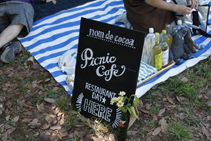
Restaurant Day
A food carnival where people anywhere can open a restaurant for one day. Started in Helsinki, Finland, it also came to Japan in 2011. The event has been held twice a year in the spring and autumn. The next Restaurant Day is scheduled to take place on August 18, 2013.
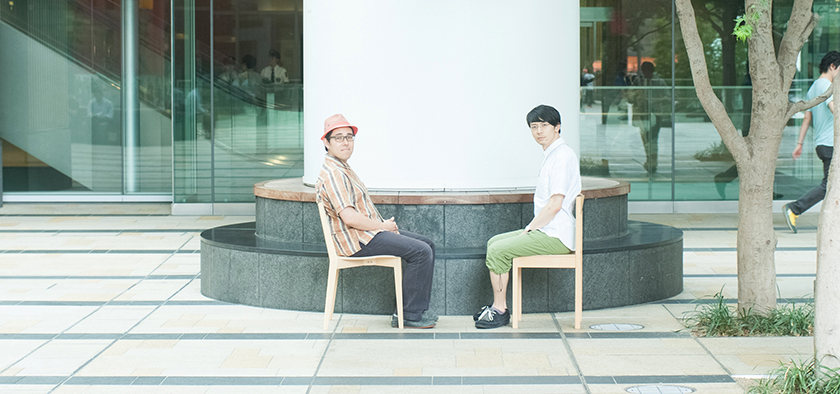
Democratizing the process of designing towns
Suzuki Of course it's possible to make communities that are not store-based. Before Kanematsu-kun arrived for the interview today, we were talking about how lovely the lawn at Tokyo Midtown is. I think it's even possible for a community to be started by asking the gardener how he looks after the lawn.
Kanematsu I suppose that by listening to the gardener, one's perspective on lawns would change. There might be more people wanting to look after the lawn.
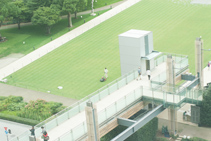
Grass at Tokyo Midtown
The lawn referred to in the interview is the Grass Square in Tokyo Midtown. Connected to the Hinokicho Park, the lawn has an expanse of around 940 square meters. There are "sakura" cherry blossom trees and kusunoki (camphor laurel) trees and a variety of plants all year round. In the autumn, visitors can enjoy the colorful "koyo" (reddening of the leaves.) By re-covering different parts during different seasons, the fresh green lawn is maintained throughout the year.
Suzuki The first step that needs to be taken is to create a venue which anyone can come to. Right now, people who come to Tokyo Midtown and Roppongi Hills can only participate by either looking at things or buying things.
In effect, there is yet no democracy in the design of town development. I think design is essentially about solving problems. Roppongi is currently a place for just the sophisticated people, but it has the potential of becoming a democratized front-line area. It could become a place for housewives and students. Many "gaps" could be created so that everyone can participate in town development, and everyone can get to know each other, from the gardener who tends the lawn to the woman who does the cleaning. And dialogue between people would lead to new things.
Kanematsu Maybe "town development" is too large a concept for many people. That's why at the social active class of "Morning University of Marunouchi" which greenz participates in, the theme is "making my town"; we start from a personal viewpoint. The members of the class may not usually give much thought to their neighborhood, but they are encouraged to come up with ideas to change the places they live in into memorable places. There are many things that people can do within that range.
This is something that's always on my mind, but between you and the person who lives next door in the same apartment, there could be possibly be a fated link. The neighbor might be earning about the same as you, or have chosen the current place because he prefers to be able to walk from the nearest station in a certain number of minutes; you and he are living in the same building because you both happened to share similar preferences. And it's rather a pity that you don't know each other. So I think it would be good if people living or working in the same town could connect with each other through the "making my town" project. This is something that could also be carried out in Roppongi.
Suzuki After about six months, more people will probably be talking to the gardener at Tokyo Midtown. Someone might say, "I heard you talk the other day. The lawn becomes damaged after an event is held, doesn't it? It must be hard work."
Kanematsu This might be a bit niche, but perhaps you could get a gathering if you called on people who love Imo-araizaka slope. People must have their own memories and episodes of Imo-araizaka slope; by sharing their stories they might come up with a variety of ideas such as planning surprises for their favorite establishments.
Club activities and surprise "thank you" events
Suzuki It's very important to set a goal. You won't gain empathy from people by saying, "Please do this for the sake of the town." At the same time, it's no use simply trying to get their participation, so it's not easy.
I think a good goal that would draw people is to use Roppongi as a place to connect people and to foster enriching relationships. And if each of the members of this project can think to themselves that they are helping to build Roppongi, then the project will naturally expand into a movement. Of course, this is something that is not achieved with planning some events - it will take place over a long period of time.
Kanematsu I think that instead of an event held by Tokyo Midtown, it might be better if a named individual - like "'so-and-so' at Tokyo Midtown" - took the initiative, because then people would be able to relate to that person and become more involved. By the way, what would you specifically do, Nao-kun?
Suzuki I guess I would try to make a community for everyone with links to Roppongi - whether they work here or just come here for leisure; it would be a community where each would feel personally involved with the town. Instead of having the conventional top-down method, it would be nice if clubs for various activities sprung up. Maybe there could be a club called "Roppongi lawn club" or a club called "Roppongi moustache club" where people wear false moustaches and have drinking parties.
Kanematsu I would like to hold a "thank you party" at the Aoyama Book Center Roppongi store. A lot of designers and other would probably join me. There seems to be so little opportunity to express one's gratitude to a town. So I would like to find ways to say "thank you" to the stores and to the City offices.
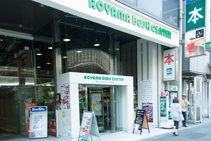
Aoyama Book Center Roppongi store
A book located within a 30-second walk from Roppongi station on the Tokyo Metro subway line. With a wide range of visual art books in genres such as photography, design and architecture, the store holds book fairs that reflect the present-day Roppongi. The store used to be open through the night until 5.am. Its numerous fans are mainly creators.
Suzuki Stores often hold "thank you" events for customers but this is about customers getting together and secretly planning a surprise "thank you" event.
Kanematsu It might be a good idea to hold a "Thank you, Almond" event! People who normally just stand and wait in front of Almond could drop in on that day. I suppose it won't be a surprise though, since I'm talking about it here. (laughs)
Editor's thoughts
Giving specific examples, Kanematsu-san and Suzuki-san talked most persuasively about how we need to think not just about using public spaces but about creating communities. They noted that communities lead to projects which eventually lead to movements. We learnt that greenz is currently undertaking an experiment to build a town called "Little Tokyo" in Toranomon. I am sure that the area must have many exciting "gaps." I would like to make a visit one of these days.(edit_kentaro inoue)




